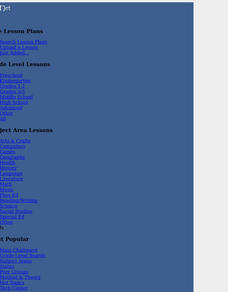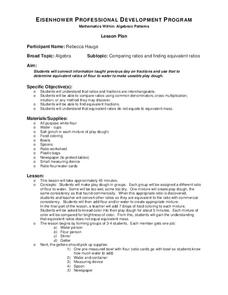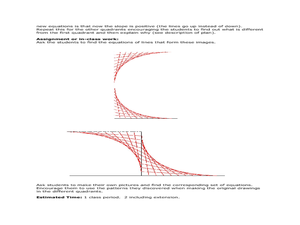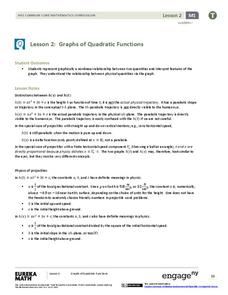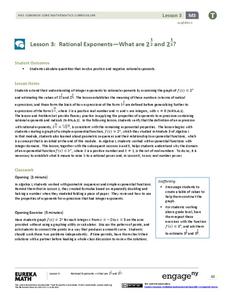Curated OER
Baseball Proportion
Students work on different mathematical skills that align with state standards. The skill of problem solving is done with reasoning and communication is made to students through solid brain connections to the math concepts.
Curated OER
Build Your Own Anemomter
Students investigate how to measure the speed of wind. They do this by building their own anemometers. Students calculate the air speeds while using their own projects and make observations. They conduct a mathematical discussion after...
Curated OER
Exponents And Monomials
Students practice different skills of mathematics used when working with exponents. The lesson has examples that can be used during direct instruction. They complete an exercise on a worksheet before advancing to a new standard.
Curated OER
Introductory Exponents
Young scholars participate in a lesson combining language arts with mathematics. First, they write a paragraph explaining what it means to multiply two numbers. Then students practice using exponents in different problems.
Curated OER
Intro to Polynomials
Seventh graders participate in a lesson introducing the mathematical concept of polynomials. They are asked questions and assessed according to the answers given during working in small groups.
Curated OER
Pictogram 1 and 2
In this mathematical worksheet, students experience problem solving two pictograms dealing with favorite animals and rainy days.
Curated OER
Transportation Math
Learners use mathematical operations to examine truck drivers and the math they use everyday. In this transportation math lesson, students read word problems that relate to transportation and the math needed to solve the word problems....
Curated OER
Exponents
Sixth graders explore mathematics by participating in a SMART Board activity. In this exponents instructional activity, 6th graders identify the different exponential powers of a number and discuss how the power of the number...
Curated OER
The Nature of Mathematics
Pupils work in groups to describe plants using numbers. In this number lesson, students use numbers to define plants and then use numbers to write descriptions of themselves.
Curated OER
Composing Music Mathematically
Students recognize relationships between mathematics and music by identifying the frequency and volume of a pure tone. Students discover that sound can be represented as a function and collect pure tones to generate smooth curves.
Curated OER
Spelling Payment (Elementary, Mathematics)
Students practice spelling words and earn points (Each spelling word is assigned a value.) for each one spelled correctly. They keep track of money earned and may purchase items at the end of the month.
Curated OER
Mathematics Within: Algebraic Patterns
Students comprehend that ratios and fractions are interchangeable. They compare ratios using common denominators, cross multiplication, and intuition. Students find equivalent fractions. They comprehend that equivalent ratios do not...
Curated OER
Mathematics of Doodles
Students use the slope and y-intercept to graph lines. In this algebra instructional activity, students graph linear equations and apply it to solving real life problems.
EngageNY
Why Were Logarithms Developed?
Show your class how people calculated complex math problems in the old days. Scholars take a trip back to the days without calculators in the 15th installment of a 35-part module. They use logarithms to determine products of numbers and...
EngageNY
The Graph of the Natural Logarithm Function
If two is company and three's a crowd, then what's e? Scholars observe how changes in the base affect the graph of a logarithmic function. They then graph the natural logarithm function and learn that all logarithmic functions can be...
EngageNY
Getting the Job Done—Speed, Work, and Measurement Units II
How fast is your class? Learners determine the amount of time it takes individuals to walk a given distance and calculate their speeds. Pupils solve distance, rate, and time problems using the formula and pay attention to the...
EngageNY
The Relationship of Multiplication and Division
Take any number, multiply it by five, and then divide by five. Did you end up with the original number? In the same vein as the previous lesson, pupils discover the relationship between multiplication and division. They develop the...
Curated OER
Algebra I: Linear Functions
Using rates from a rental car company, young mathematicians graph data, explore linear relationships, and discuss the role of slope and the y-intercept. This lesson allows for the discussion of independent and dependent variables, as...
EngageNY
Graphs of Quadratic Functions
How high is too high for a belly flop? Learners analyze data to model the world record belly flop using a quadratic equation. They create a graph and analyze the key features and apply them to the context of the video.
EngageNY
Modeling Riverbeds with Polynomials (part 1)
Many things in life take the shape of a polynomial curve. Learners design a polynomial function to model a riverbed. Using different strategies, they find the flow rate through the river.
EngageNY
Trigonometric Identity Proofs
Proving a trig identity might just be easier than proving your own identity at the airport. Learners first investigate a table of values to determine and prove the addition formulas for sine and cosine. They then use this result to...
EngageNY
Construct an Equilateral Triangle (part 1)
Drawing circles isn't the only thing compasses are good for. In this first installment of a 36-part series, high schoolers learn how to draw equilateral triangles by investigating real-world situations, such as finding the location of a...
EngageNY
Rational Exponents—What are 2^1/2 and 2^1/3?
Are you rooting for your high schoolers to learn about rational exponents? In the third installment of a 35-part module, pupils first learn the meaning of 2^(1/n) by estimating values on the graph of y = 2^x and by using algebraic...
EngageNY
Base 10 and Scientific Notation
Use a resource on which you can base your lesson on base 10 and scientific notation. The second installment of a 35-part module presents scholars with a review of scientific notation. After getting comfortable with scientific...
Other popular searches
- History of Mathematics
- Discrete Mathematics
- Mathematics Line Symmetry
- Everyday Mathematics
- Montessori Mathematics
- Writing in Mathematics
- Mathematics Mode and Median
- Applied Mathematics
- Mathematics Times Tables
- Christmas Mathematics
- B Ed Mathematics
- Discrete Mathematics Graph












